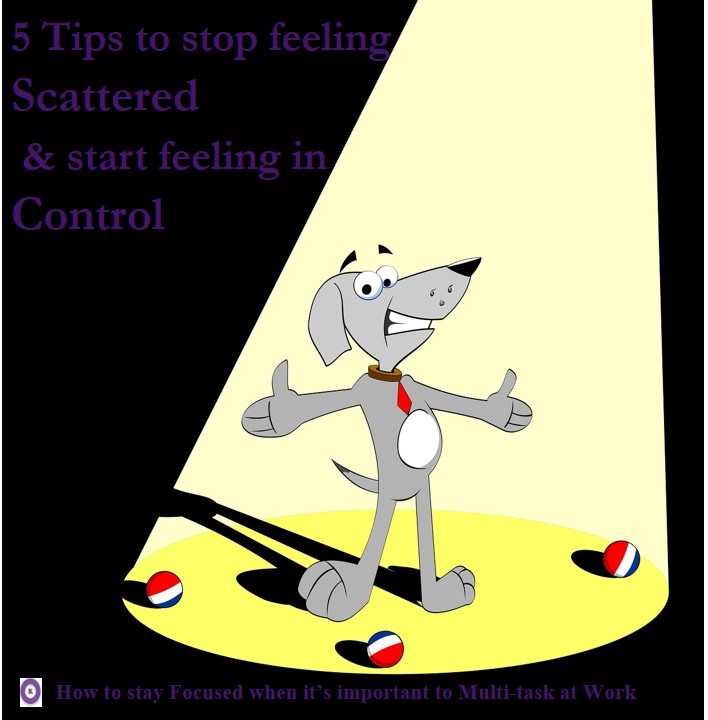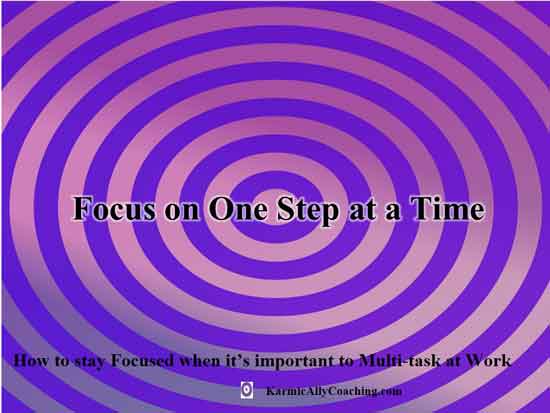This post has already been read 680 times!

Multi-tasking is an essential skill in the current corporate world and cannot be ignored as I had pointed out in an earlier post.
Your challenge then is how to do it without adversely impacting your Executive Presence or productivity.
But Multitasking does have its drawbacks.
According to The Harvard Business Review, this behavior can lead to as much as a 40 percent decrease in productivity. It takes workers time to switch mindset from one task to another, and doing so may not be in the best interest of your work group. In addition, it can negatively impact your company’s bottom line.
An article I read about the impact of multi-tasking in the workplace, points out how this can raise stress and anxiety in a worker and even possible burnout.
I’m not surprised. Clients who engage me as their coach for building their Executive Presence always have time management issues.
The side-effects of multi-tasking also have to be addressed.
That’s because multi-tasking over stimulates your brain function and you lose your ability to differentiate between the important and not so important tasks. It also blurs the line between tasks that are urgent and not so urgent.
Priority tasks get mingled with activities that aren’t really urgent and sadly, the Covey Quadrant or Blanchard Quadrant approach to prioritization of tasks doesn’t work for these professionals because they aren’t able to think with a clear mind.
Having said that, there’ll always be jobs where this skill is essential for completing tasks, like customer service representatives, nurses, bank tellers, bartenders, receptionists, and other front-end roles for examples.
To serve customers better, they must attend to several tasks at once.
But this same skill can become a hindrance for professionals who need a high level of concentration at work such as accountants or data entry specialists, to name a few.
I mean, have you ever heard of a surgeon multi-tasking on patients in the operation theater?
Focusing on one task at a time is necessary for these roles to produce quality and accurate outputs.
The era of multi-tasking has generated a disturbing phenomenon – our inability to focus on just one thing at a time and experiencing scattered brain syndrome.
Even if we aren’t willing to admit it openly, most of us feel scattered a good portion of the day. That’s because we’re always juggling many things at once and never have our brains entirely concentrated on one task at a time.

5 Tips to stop feeling Scattered & start feeling in Control
While I have an entire course on effective time management for professionals, here are 5 tips to help you learn to focus.
#1. Remove Distractions
Before you embark on becoming more focused, identify the things that are most likely to distract you.
Do you find yourself always looking at the notifications on your phone? Turn them off.
Do you constantly browse social media when you should be working? Install a plugin on your browser that limits how much time you spend on specific sites.
Turn off anything and everything you can that can be a distraction, including ringers, pop-ups, and other noises or visuals that pull you out of your zone.
If you focus better while listening to music, put your headphones on and select your best tunes before you start working.
Whatever it is you need to do, get your environment set to be as distraction-free as possible.
#2. Prioritize Your To-Dos
This one is often on the top of lists related to productivity for a good reason. The act of writing down what needs to be done helps to declutter your mind and get a handle on everything rattling around up there.
After it is all down on paper (or your phone) prioritize what needs to be done first. These are your tasks that MUST be done today (or by lunch, etc).
#3. Pick One and Break it Down
Start with your most pressing goal. Simplify it into its most basic steps or actions, which should take no more than 20 minutes for each.
If a step will take longer, break it down even further. Once you have a clear outline of how to accomplish the goal, you are ready to begin.
#4. Start Working. Focus on One Step at a Time
Since you know exactly what needs to be done and how long it will take, you do not need to rush, and you can focus on one thing at a time. Focus on getting that first step done.
It will take less than 20 minutes, which means your brain can concentrate for that long without interruption. Do each step deliberately and do not try to do anything else while you’re at it.
Once you are done with that step, evaluate how you feel. Do you need a break? Are you ready for the next step?

#5. Break up the Day
If you start to feel agitated or anxious, it is okay to break up your time by getting up to move or doing another very small task.
But do one little thing and then come back to your priority.
The more you neglect the important stuff on your list, the more scattered your brain will feel. After you have completed four steps or tasks, you should take a real break.
During this time, you can check your social media, read blog articles, or indulge in your guilty pleasure that you have been avoiding while you were working.
Bonus Tip: Focus on Tasks, Not the Clock
It doesn’t matter what time it is or how long you have been working. Focus on checking off the steps in your list or the tasks you have prioritized.
If you need some boundaries, set a timer for 20 minutes and work consistently until you hear it go off. Take a short break, and then return and start again. The more you practice this, the easier it will become as you build your stamina for focus.
Retraining a scattered brain takes time and diligence, but it can happen.
Be assured that you will slowly but surely start feeling like your mind can focus and you do not feel so scattered all the time.




 I adhere to the Certified Coaches Alliance Code of Ethics and Standards. A copy is available on request.
I adhere to the Certified Coaches Alliance Code of Ethics and Standards. A copy is available on request.
 Let's Talk through the Connect Form:
Let's Talk through the Connect Form: